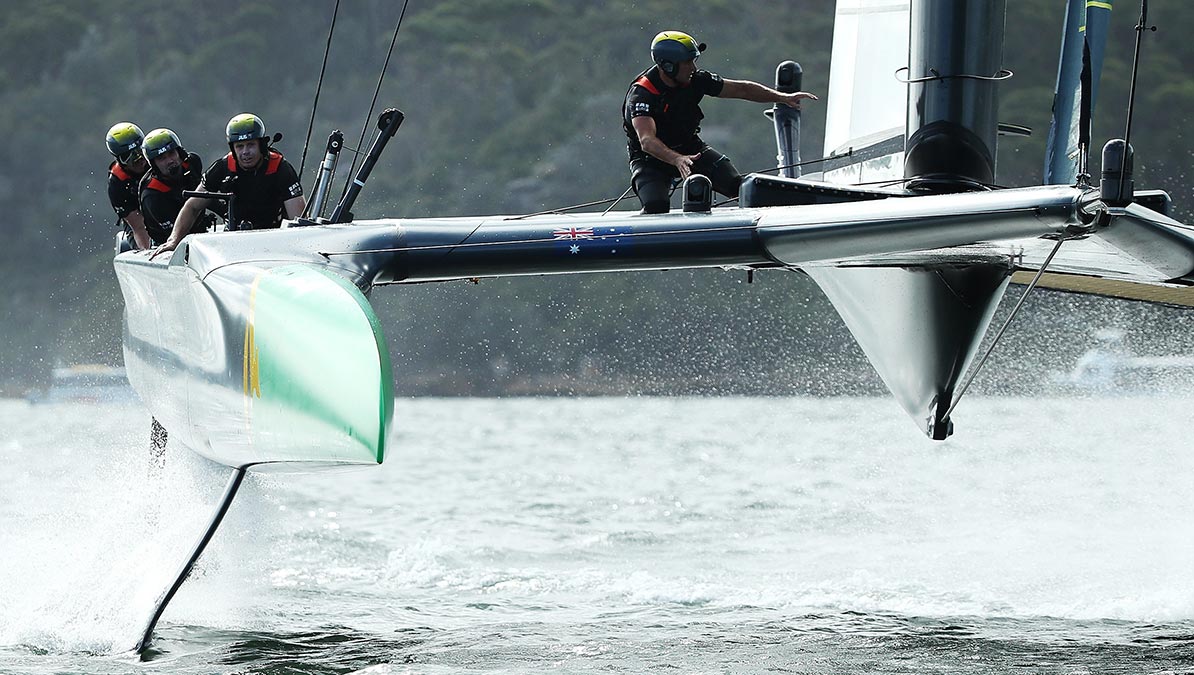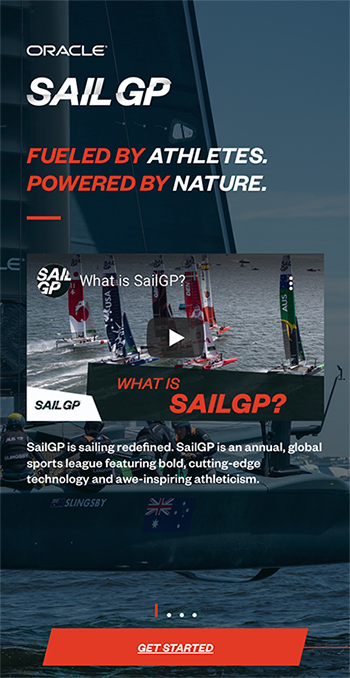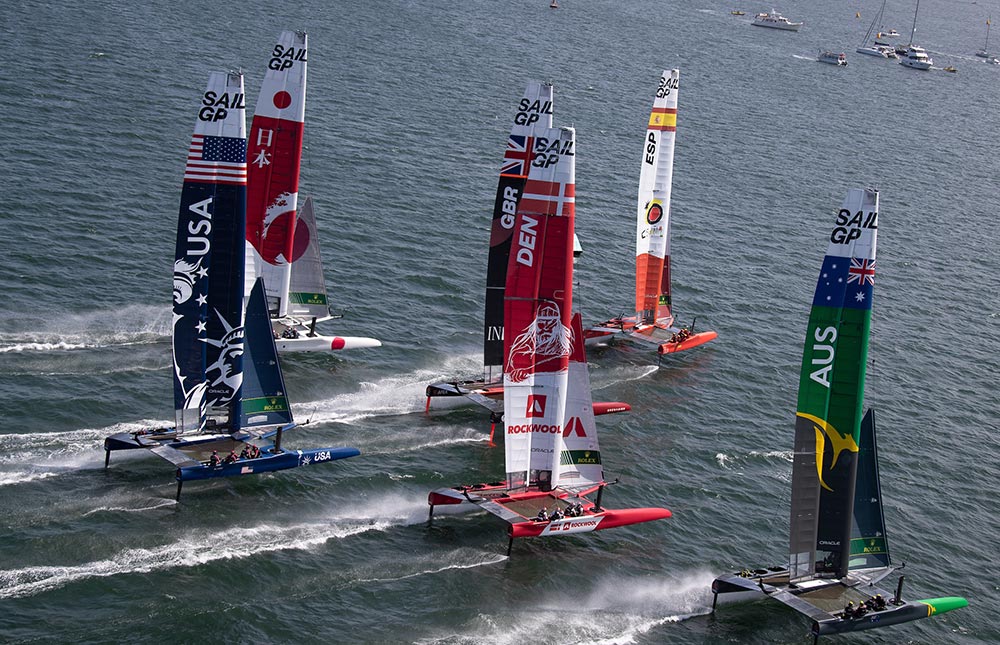Innovative racing league kicks off Season 2 on April 24, offering a range of new data-powered insights.

As the SailGP championship kicks off a second season of racing April 24 in Bermuda, the league will pair 50-foot catamarans capable of exceeding 50 knots (60 mph) with an array of sensors and cloud technologies that can instantly collect and analyze millions of data points detailing every aspect of a race. All this high technology serves a simple purpose: to wow fans and help ensure that the best sailors win.
The innovative SailGP championship gives its eight national teams as well as broadcast partners, fans, and race officials access to an unprecedented array of data collected, analyzed, and stored on Oracle Cloud systems.
 |
| The SailGP mobile app lets fans drill down into a range of stats, including race positions and penalties incurred, as well as each boat’s ride height, time to mark, and velocity. |
During each of the 20-minute races during Season 2, thousands of sensors attached to the teams’ F50 catamarans and their crew members will send millions of data points—via Oracle Cloud Infrastructure’s FastConnect platform—to an Oracle cloud region in London for analysis and distribution worldwide. “This all happens and is consumable for end users within 150 milliseconds—faster than a blink of an eye,” says Joey Fitts, Oracle vice president of analytics product strategy.
That data is used for a variety of purposes: It helps SailGP’s eight teams evaluate and adjust their equipment and tactics for future races; it feeds the TV broadcast’s on-screen graphics and analysis; it gives fans a rich source of information on the SailGP mobile app and on SailGP.com; it lets teams monitor their athletes’ heart rates and blood pressure levels, as well as track their movements on the boats; and it gives race officials the details they need to make calls with more confidence.
The SailGP league is unique in that all of the teams’ F50 sailing machines are designed and engineered to be identical—in part to minimize development costs, but also to place a greater emphasis on tactics. And those millions of data points streamed from the F50s are shared among all the teams via a cloud-based Oracle Autonomous Data Warehouse.
“Teams can examine and learn from each other’s winning maneuvers as well as their own,” Fitts says.
Did the team that won the prior race gain an advantage because of the angle of its wing twists in certain tacking situations or because it was able to foil above water for longer periods of time than its competitors? Each team can customize its dashboard to capture the data it determines is most relevant to improving its performance.
Wowing fans
Data streamed to broadcasters, the SailGP app, and SailGP.com also improves the fan experience. Video and audio feeds from cameras and microphones on each of the boats bring the onboard action to fans on all three of those media channels.
On the app, available on Google Play or the Apple App Store, data sent via Oracle Stream Analytics lets fans drill down into a range of stats, including race positions and penalties incurred, as well as each boat’s ride height, time to mark, and VMG (velocity made good, indicating velocity in an upwind or downwind direction). Fans can also compare in real time the race stats of two teams they select.
One compelling new feature—to be available on the SailGP app, broadcast, and data dashboards later this year—is a real-time rating, on a scale of 1 to 10, of each team’s tacks into the wind, calculated using Oracle AI technology.
Also new this season will be a SailGP race simulator, akin to a flight simulator, with a Dynamic Velocity Prediction Program that lets team members virtually race their F50 catamarans for training purposes, from any location. Using the program’s visualization technology on an Oracle workstation, which accesses Season 1 data stored in Oracle Autonomous Data Warehouse, the athletes can take the helm, wing trimmer, or flight controller positions to experience racing under different conditions. Fans will be able to take a virtual F50 for a spin at future SailGP events.
| “Our cutting-edge, global league never stands still as we continue to push the boundaries of what is possible, both on and off the water.” |
| —Russell Coutts, CEO, SailGP |
“Our cutting-edge, global league never stands still as we continue to push the boundaries of what is possible, both on and off the water,” says SailGP CEO and yacht racing legend Russell Coutts. “For Season 2, we’re working on a number of new cloud-based innovations with Oracle to truly enhance the viewer experience and create efficiencies in the way we operate across all aspects of our business. The results are remarkable, especially on race days, which are the ultimate showcase of data, technology, and invention.”
Ariel Kelman, Oracle executive vice president and chief marketing officer, notes that SailGP and Oracle are natural partners given that SailGP is “one of the most data-rich sports leagues in the world, and data is in Oracle’s DNA. The differentiator in our collaboration this season is the advancements in extracting meaningful information from massive amounts of data and the mind-boggling speed at which it’s done.”
‘Climate positive’ series
SailGP not only is on the cutting edge of racing technology and data analysis, but it’s also partnering with Oracle and many other organizations to reduce—and more than offset—its carbon emissions in order to become the first “climate positive” sports and entertainment property.

SailGP’s national teams and their data-enriched sailing machines compete during Season 1.
Oracle, for example, has committed to running all of the cloud regions that power its infrastructure and application services on 100% renewable energy by 2025. Another example is SailGP’s partnership with ELG to recycle carbon fiber waste from the F50s for use in the boat manufacturing process for future seasons. SailGP is partnering with three other companies to reduce the carbon impact of its support boats, with the goal of having a fully electric fleet of such boats by 2025.
Season 2 also marks the first time SailGP will coordinate all data and production activities for each race remotely, reducing the costs and environmental impact of sending large crews and equipment to each event.
SailGP Season 2 will feature an expanded calendar of races, building on the global footprint of the five-race, six-team Season 1. Tom Slingsby’s reigning champion Australian team will face crews from France, Great Britain, Japan, and the US, as well as series newcomers Denmark, New Zealand, and Spain, following the suspension of the 2020 campaign because of COVID-19.
After opening Season 2 April 24 and 25 on Bermuda’s Great Sound, the same venue as for the 2017 America’s Cup races, the SailGP teams will head in succession to waters off Italy, Great Britain, Denmark, France, Spain, and New Zealand, before culminating on San Francisco Bay March 26 and 27, 2022, in a single, $1 million winner-takes-all final.
Dig deeper
- Learn more about the innovative SailGP racing championship series
- Learn more about Oracle’s next-generation cloud infrastructure
- Read the SailGP-Oracle joint press release
- Get started with Oracle Cloud for free
Photography: SailGP; Cameron Spencer/Getty Images